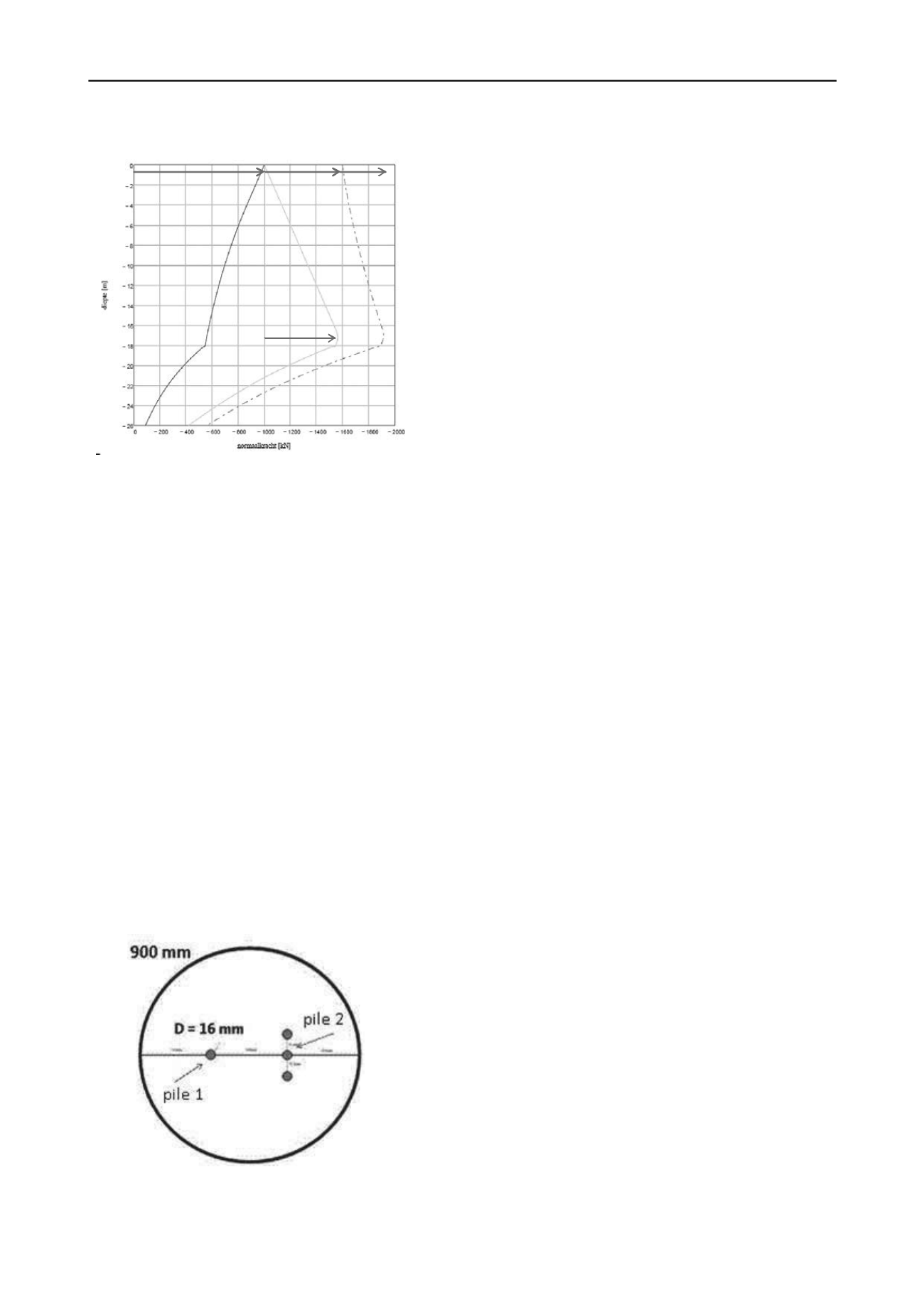
2888
Proceedings of the 18
th
International Conference on Soil Mechanics and Geotechnical Engineering, Paris 2013
The test set-up is shown in Figure 6. Two instrumented test
piles will be installed in a single sample preparation in the
container, one single pile and a pile in a group of 3 piles. The
two test piles and the other piles in the group will be installed in
flight. To study the time effect, pile1 will be test loaded at 1, 10,
100 and 1000 minutes after installation. Then pile 2 will be
loaded in the group using the same time schedule. The
centrifuge will continue to operate from the start of the
installation until the final load test.
Figure 5. Normal forces as function of depth and a wind load of 600 kN
7 CONCLUSIONS AND FOLLOW-UP
The conclusion of the study of concealed safety factors is that
the time effects and the pile group effects are the two effects
most likely to contribute to concealed safety. It will therefore be
useful to look at time effects more closely. The primary focus
should be on quantifying and understanding the effect,
determining the impact of load variations and identifying the
applicable limitations. Furthermore, it is recommended to
continue with research into pile group effects of displacement
piles: the impact of compaction, focusing in particular on the
impact on pile-base capacity in combination with the
sequencing of installation.
7.1 Pilot tests in geotechnical centrifuge
The follow-up research will include pilot testing in a
geotechnical centrifuge looking at concealed safety factors. This
test will look at the time and the group effect. The design of this
pilot test will focus primarily on determining whether the
phenomena in question can be studied in the centrifuge. It is
generally thought that creep (the process underlying set-up)
cannot be modeled in a centrifuge because time cannot be
scaled during testing. However, longer centrifuge testing can
lead to the determination of the size of factor A in equation 1. If
this is the case, research can be conducted in the centrifuge,
precluding the need for more expensive field studies and
allowing controlled conditions.
Figure 6. Centrifuge test design, test piles with a diameter of 16 mm in a
00 mm diameter container.
9
8 REFERENCES
Axelsson, G. 2000.
Long-Term Set-up of Driven Piles in Sand.
Div. of
Soil an Rock Mechanics. Dep. of Civil and Environmental
Engineering. Stockholm, Royal Institute of Technology.
API 2007. Recommendations RP-2A-WSD
Baxter C.D.P. & Mitchell, J.K. 2004. Experimental study on the ageing
of sand.
J. of Geotechnical and Environmental Engineering
130
(10); 1051-1062.
Bustamente, M., Gambin, M. & Gianeselli, L. 2009. Pile design at
failure using Menard pressuremeter; an update.
ASCE Geotechnical
special publication
(GSP 186), 127-134.
Chow, F., Jardine, R.J., Nauroy, J.F., Brucy, F. 1997. Time related
increases in the shaft capacities of driven piles in sand.
Geotechnique
47 No2.: 353-361.
CUR 2010. CUR 229:
Axiaal draagvermogen van palen
. Gouda.
Foray, P.L., Balachowski & Colliat, J.L. 1998. Bearing capacity of
model piles driven into dense overconsolidated sands.
Can.
Geotechn. J.
35 374-385.
Jardine, R.J., Chow, F. C., & Standing J.R. 2006. Some observations of
the effects of time on the capacity of Piles driven in Sand.
Geotechnique
56 no 4: 227-224.
Joshi, R.C., Gopal Achari, Shenbaga Kaniraj, R. Wijeweera, H. 1995.
Effect of ageing on penetration resistance of sands,
Can. Geotechn.
J.
325: 767-782.
NEN-9997-1, 2012,
Geotechnical design of structures,- Part 1: General
rules
, NEN, Delft
Skov, R. and Denver, H. 1988. Time-dependence of bearing capacity of
piles.
Proc. 3rd. Int. Conf.on Application of Stress-wave Theory to
Piles
, Ottawa, Canada.
Sobolewsky, D.Y. 1995.
Strength of dilating soil and load-holding
capacity of deep foundations
. Rotterdam, A.A. Balkema, ISBN 90
5410 164 4.
Stoevelaar, R, Bezuijen, A., Lottum, H. van & Tol, A.F. van. 2011.
Effects of crushing on point bearing capacity in sand tested in a
geotechnical centrifuge.
15th European Conf. ISSMGE Athens
.
Van Tol, A.F., Stoevelaar, R. and Rietdijk, J. 2010. Draagvermogen van
geheide palen in internationale context.
Geotechniek
december.
Van Tol, A.F. and Everts, H.J. (2003). New foundation technology -
The limits of driving prefabricated concrete piles. In I. Vanicek &
R. Barvinek (Eds.),
Geotechnical Problems with man-made and
man influenced grounds
(pp. 503-510). Praag: The Czech
Geotechnical Society CICE.
Xu, X., Schneider, J.A.& Lehane, B.M. 2008. Cone penetration test
CPT methods for end-bearing assesment of open- and closed-ended
driven piles in siliceous sand.
Can. Geotech. J
. 45: 1130.
Fs;g = 1000 kN Fs;wind = 600 kN
Fs;nk = 300 kN
with wind
Fs;nk = 550 kN
without wind


